Robot tanks: On patrol but not allowed to shoot
- Published
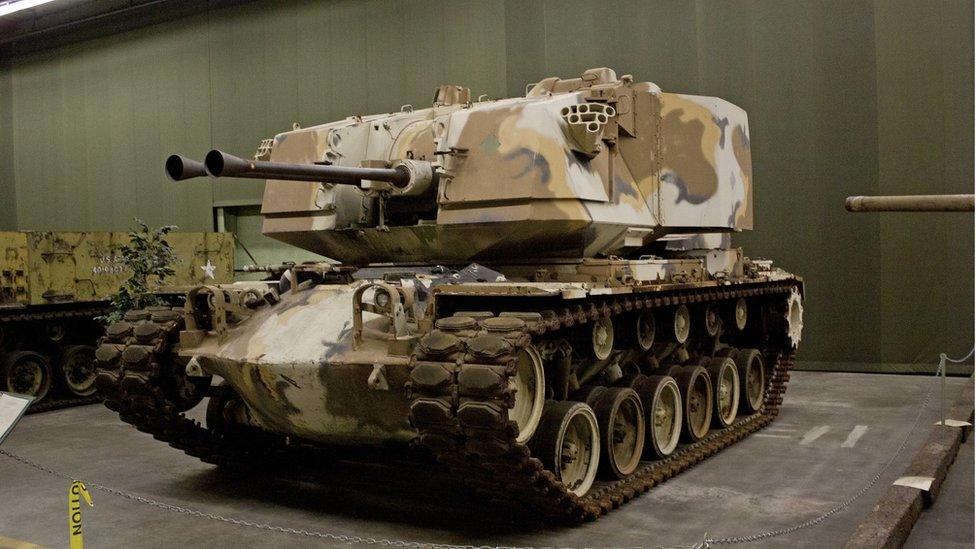
The M247 Sergeant York was abandoned by the US Army in 1985
In 1985 the US pulled the plug on a computer-controlled anti-aircraft tank after a series of debacles in which its electronic brain locked guns onto a stand packed with top generals reviewing the device. Mercifully it didn't fire, but did subsequently attack a portable toilet instead of a target drone.
The M247 Sergeant York (pictured above) may have been an embarrassing failure, but digital technology and artificial intelligence (AI) have changed the game since then.
Today defence contractors around the world are competing to introduce small unmanned tracked vehicles into military service.
Just like an army on the move, there are contrasting views about how far and how fast this technology will advance. Above all, designers are testing the limits of human control and machine independence, the ultimate goal of autonomy.
Will this new generation of mini-tanks change the face of warfare? How much autonomy can they be trusted with?
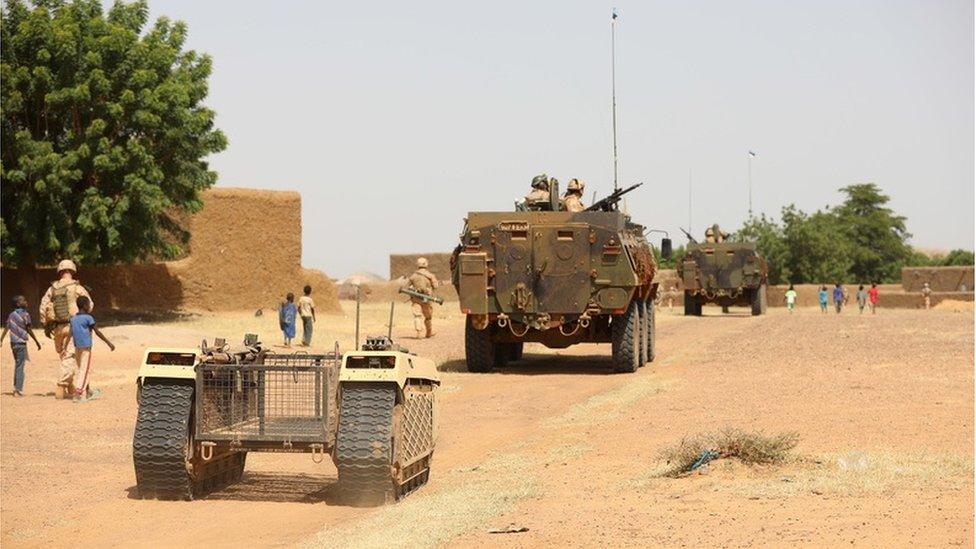
The Milrem unmanned vehicle with Estonian troops in Mali
Estonian soldiers currently serving in Mali are going out on patrol with an unmanned ground vehicle or UGV. The size of a sit-on lawn-mower with tracks, it carries heavy supplies such as water and ammunition. Trundling behind a conventional armoured personnel carrier it resembles an obedient younger sibling.
UK defence technology group Qinetiq presented the British army with a selection of these vehicles during a month-long trial on Salisbury Plain in late 2018. The basic UGV came from the Estonian company Milrem, but Qinetiq integrated a series of technology options onto it to create a trio of military roles.


Depending on the option chosen the UGV, known as Titan, can carry supplies or a heavy machine gun, or it can stand guard over its human comrades, using infra-red sensors and thermal imaging to supplement a battery of cameras.
Running on an electric-diesel hybrid engine Titan can be controlled by a human operator or sent off to perform tasks directed by its own software which can decide when to switch between power sources.

The Titan can carry supplies or a heavy machine gun
Keith Mallon is in charge of UGVs at Qinetiq. While a small tank weaving across a muddy plain is a curious sight, he focuses on the digital contents of the UGV.
"We've had robotics for years, but the information revolution means it can navigate on its own."
Machine learning, a subset of the Artificial Intelligence (AI) revolution, means software embedded in Titan recognises patterns. Data from its cameras and other sensors is matched to prior examples so it can navigate to a chosen destination.
The idea is to have minimal human intervention while Titan goes about supporting the troops or exploring a dangerous area. But the freedom Qinetiq will grant to the UGV is strictly limited.
When it comes to firing a gun or anti-tank missile mounted on the chassis a human must always be in the loop to decide on the use of lethal force. "We will never give software the capability to fire a weapon," says Keith Mallon.
Does all this mean robot mini-tanks have really won acceptance?
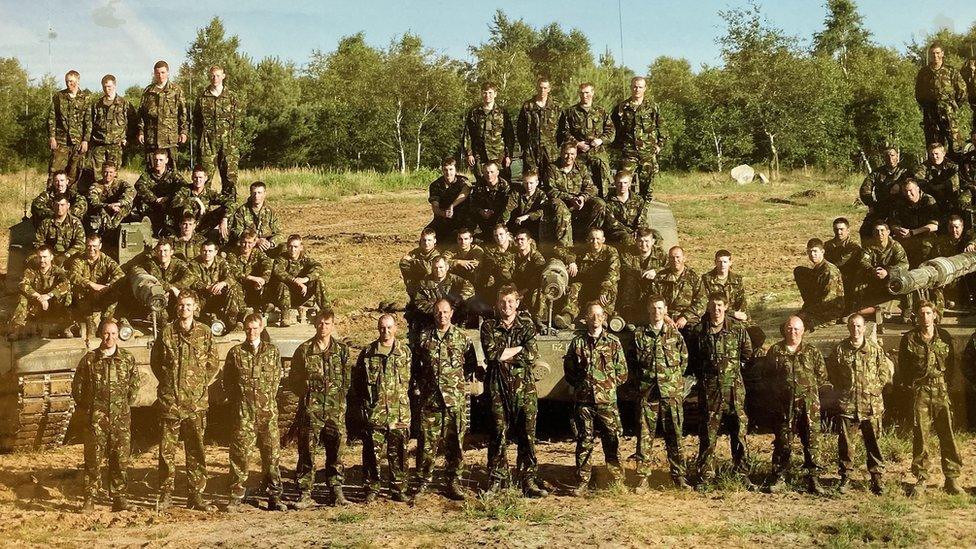
Nick Entwistle (front, middle, arms folded) with Challenger 2 tanks
Nick Entwistle spent 19 years serving in the British army in tanks and armoured vehicles. Today he advises the army and has studied the results of the Salisbury Plain trials. He points out that warfare throws up choices that go way beyond the capabilities of current AI technology.
"Even humans have trouble discriminating between a civilian and a combatant. And human beings are adept at reading situations. But look at Afghanistan where the enemy hid among civilians. So autonomy is not going to happen for some time. The technology is further away than some like to think."
Across the Atlantic US defence contractor FLIR has been buying up robotics firms in order to put together a UGV package with a group of technology and engineering firms, Team Ripsaw. This group has adapted the Ripsaw, a small tracked vehicle with sports car speeds popularised on TV and by Hollywood.

A version of the Ripsaw tank was used in the Fast & Furious movie
Originally marketed as a millionaire's plaything and subsequently starring in Fast and Furious 8, the Ripsaw may be about to earn further recognition as an unmanned war machine.
It has been chosen for detailed testing by the US Army's Robotic Combat Vehicle (RCV) programme. After evaluating a whole crop of UGVs the army intends to field some for real by the mid-2020s.
Team Ripsaw uses a handful of sophisticated visual and thermal sensors to see all around the UGV in day and night. These sensors live inside a gimbal on a mast that can be extended to peer far and wide. The big challenge is to pre-plan a mission and then let the UGV go and do it independently of an operator with radio control. This is where AI comes in.
David Ray is a senior FLIR executive and ex-US Air Force communications expert who served on Air Force One. As he sees it AI is "about object detection, how you tell the difference between a broomstick and a gun".
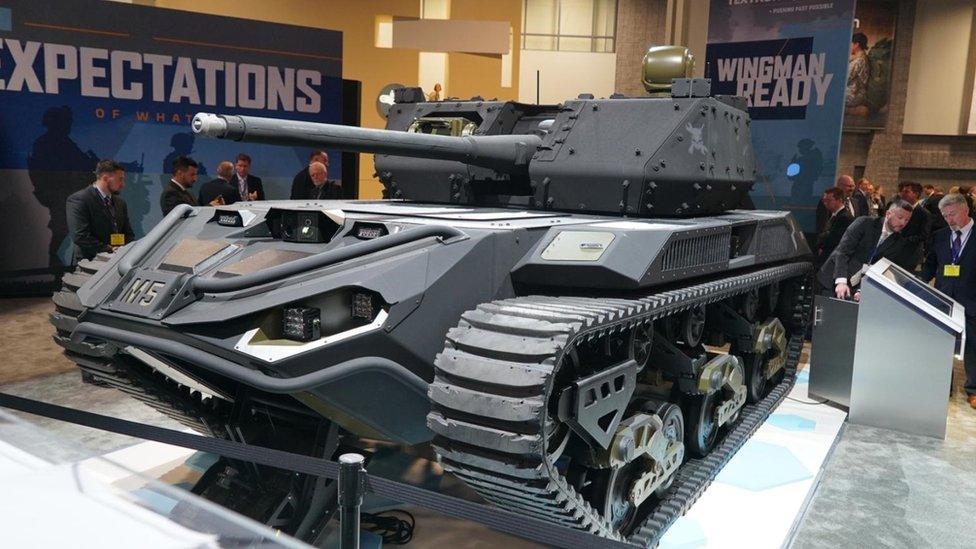
The Ripsaw M5 is designed to protect crewed tanks
Again, machine learning is the key, showing the Ripsaw's digital mind a succession of images that build up a comparative picture of the world.
Self-driving cars can be programmed to recognise everyday events from videos. But you simply cannot show a machine real images of every possible situation that might arise in war.
So synthetic training aids, familiar from flight simulators and using hyper-realistic computer-generated images have been brought to bear. These reflect combat conditions. The machine-learning software builds up a library of capabilities as it absorbs images of conflict.
This merging of different technologies represents a big breakthrough for UGVs.
David Ray talks of the Ripsaw as "very fast and flexible and able to traverse difficult terrain such as sand dunes". It uses an electric-diesel hybrid motor that can transition to a silent approach in stark contrast to the barrage of noise laid down by conventional tanks. The US Army wants a discreet machine that can creep up on its target.
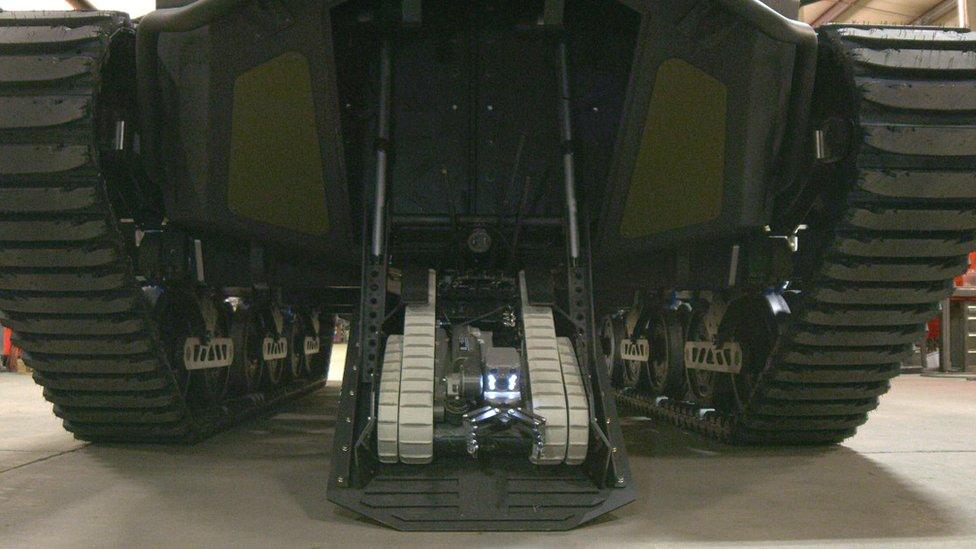
The Ripsaw carries a smaller robot that can get into smaller spaces
The real revelation about the Team Ripsaw vehicle lies in what FLIR calls its marsupial character. The little tank can open a hatch under its angled front to disgorge a junior robot partner, a smaller tracked machine based on a bomb disposal robot. This scuttles away into confined spaces to look for enemies lurking inside buildings or to detect toxic substances such as nerve agents.
The robot family doesn't stop there. A quadcopter drone can rise from the rear of the UGV to carry out aerial reconnaissance on behalf of its terrestrial team-mates.
This is layered surveillance, keeping manned vehicles well back from danger while a trio of tech-heavy toys spy on threats. Like Titan, Team Ripsaw has an armed option which resembles a smaller version of a normal tank.
As with his UK counterparts, David Ray is emphatic that a human will always be in the loop before firing.